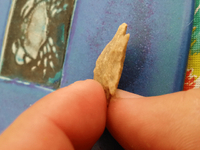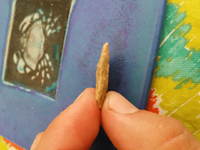Flathead25
Full Member
- Mar 12, 2013
- 105
- 133
- Detector(s) used
-
Nautilus DMC-IIBa
AT Pro
- Primary Interest:
- All Treasure Hunting
Upvote
0
 and Charl nailed it.
and Charl nailed it."Many argue that the Kirk Serrated and the Kirk Stemmed point are the same and do not distinguish between them. Others argue that they are separate points that need to be identified as separate points based on the base of the points (Justice, 1987). The Serrated point commonly has a concaved to bifurcated base while the stemmed point is most commonly straight, however, there are serrated straight bases and unserrated bifurcated examples. Johnson et al. (2009), argues that the base is the sole identifier for the different points and that not all Kirk Serrated points are serrated and that some of the Kirk Stemmed points are serrated."
I'm not sure I fully understand this. We use basal configuration to distinguish point types but other characteristics of the point help distinguish when a point was made. I have some Kirk Serrated points and I think only one of them has a slightly bifurcated base. It is what I call an "Old Kirk". Provenience makes all the difference in the world and with the Archaic period being so long, there are many possible groups of people that lived during this time period. We don't know the dates the people that made the Kirk cluster points, but we can see the differences. I have probably studied them more than most. Here are some thoughts excluding the Kirk Corner Notch.
In NW FL, there were at least four distinct groups of Kirk peoples. These are groups (bands) of people who made specific types of Kirk points and most lived at different times during the Archaic period. There cultures were very similar and not distinguishable by anything other than the style of points they made. I call the first Kirks the "Old Kirks". I like to call the ones that everyone finds the regular Kirk points.. One could argue that Six Mile Creek and serrated Pickwicks could be included but they come later.
Varying Kirk Peoples or bands made these points:
1. Old Kirks - Some may put the LeCroy point in this group but they are a separate group of people.
2. Regular Kirk Serrated - what most people find. The only difference between Kirk Serrated and Kirk Stemmed is the serrations.
3. Abbeys and South Prong Creek (localized to the Tristate area)
4. The Kirks - A unique group of people that made extremely precise points. I had one site that made these points which makes me think these people we just passing through and didn't stay long. They made Kirks, but they aren't regular Kirks. I only found 15 or 20 points on this small, isolated site with no apparent water source. Of those points, several are in my good case and the others are exceptional. They liked big points, big and precise serrations and only used good materials. I don't feel these people lived as long ago as the other peoples due to the patination of the points. I lost access to this site a year or two after I was given permission to look it and only looked it a few times. They were magnificent craftsmen.
I wouldn't call it a Kirk. It may be from the same time period, but NE probably has a different name for it. Nice point.

I wouldn't call it a Kirk. It may be from the same time period, but NE probably has a different name for it. Nice point.
I would call the first one a Kirk Stemmed Serrated Point. There are Kirk Stemmed Points that aren't serrated though, as Charl pointed out. Can we see a shot looking down on the base of the second Point? That may be a Decatur Point if it shows burins on the base.


